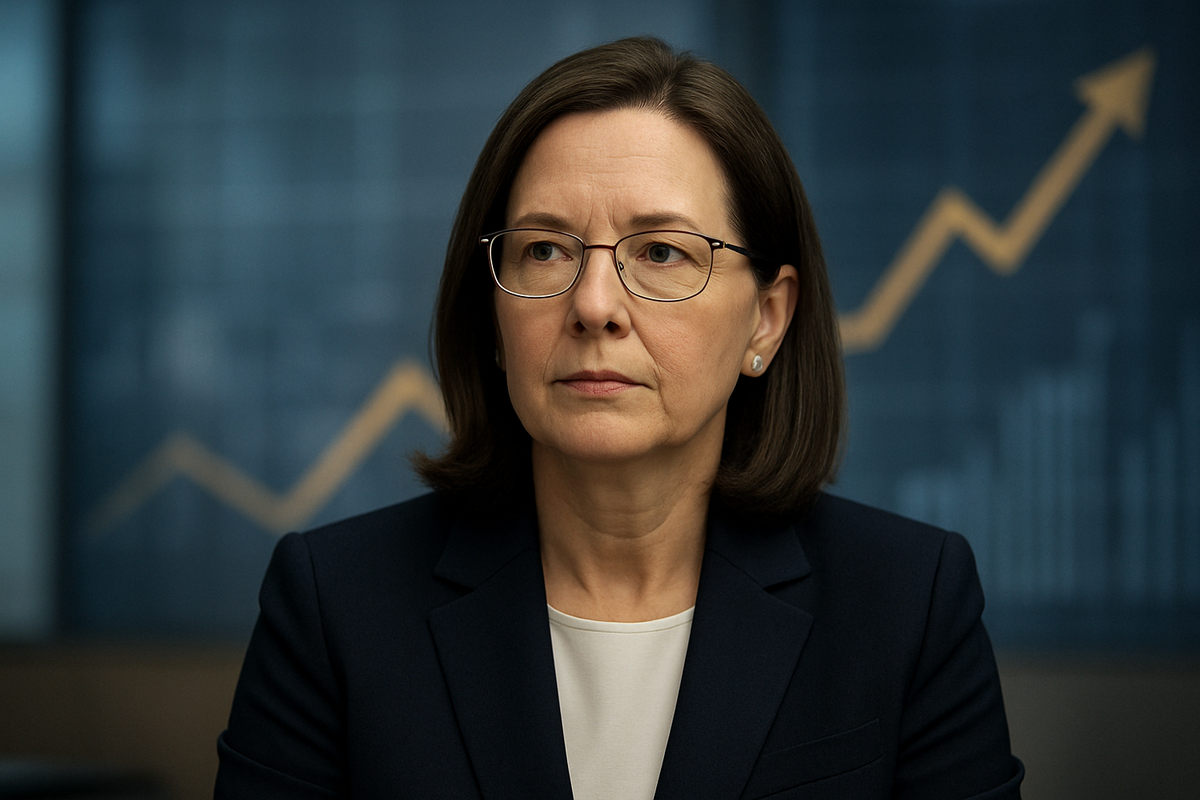
Dallas Federal Reserve President Lorie Logan has emerged as a prominent voice of caution within the central bank, expressing significant doubts about the necessity of further interest rate cuts in December. Her recent statements, delivered in late October 2025, underscore a more hawkish perspective within the Federal Open Market Committee (FOMC), emphasizing persistent inflation and a resilient labor market as key deterrents to immediate monetary easing. This stance has immediate implications for market expectations, signaling a potential prolonging of the "higher for longer" interest rate environment and a continued focus on price stability over rapid economic stimulus.
Logan's skepticism about further rate reductions has sent ripples through financial markets, causing a notable shift in the perceived probability of a December rate cut. Her comments suggest a cautious approach by the Fed, indicating that any future easing will be contingent on undeniable evidence of sustained disinflation and a more pronounced cooling of the labor market. This cautious outlook could mean a tighter financial landscape for businesses and consumers well into the coming year.
Logan's Hawkish Stance: A Deep Dive into the Fed's Internal Debate
Dallas Federal Reserve President Lorie Logan's late October 2025 remarks have brought into sharp focus the internal deliberations within the Federal Reserve regarding the trajectory of interest rates. Logan explicitly stated that she "did not support the central bank's decision to cut interest rates this week" (referring to a likely September or early October FOMC meeting) and would "find it difficult to back another reduction in December." Her preference would have been to maintain steady rates, highlighting a belief that recent easing measures may have been premature.
Her reasoning is primarily anchored in concerns over persistent inflation, which she believes remains "too high and likely to exceed 2% goal for too much longer." Logan pointed to non-housing services inflation, hovering around 3.4% over the past year, as a significant factor that could keep overall inflation 30 to 40 basis points above the Fed's 2% target. Additionally, she cited potential upside risks to inflation expectations stemming from tariffs. Complementing her inflation concerns, Logan described the labor market as "roughly balanced" and cooling at a gradual, rather than rapid, pace. She noted that despite some slowdown in job creation, layoffs and unemployment claims have remained low, suggesting the labor market is absorbing changes without a drastic rise in unemployment. She views earlier rate cuts as sufficient "insurance" against a severe labor market downturn, implying current conditions do not warrant further preemptive action.
Key players involved in this ongoing debate include other hawkish Fed officials like Kansas City Fed President Jeffrey Schmid, who has echoed similar sentiments, indicating a growing divergence of views within the FOMC. This divergence sets the stage for potentially intense debates leading up to the December FOMC meeting. Following Logan's remarks, the probability of a 25-basis point rate cut in December, as tracked by the CME FedWatch tool, dropped from 72.8% a week prior to 60.8%, reflecting immediate market reactions to her hawkish stance. The U.S. Dollar Index also saw a modest rise, reflecting investor anticipation of a tighter monetary policy environment.
Market Implications: Winners and Losers in a Higher-for-Longer Scenario
A prolonged "higher for longer" interest rate environment, as signaled by Logan's comments, will inevitably create distinct winners and losers across various sectors of the financial market. Companies with robust balance sheets and less reliance on external financing are better positioned to weather this period, while those with significant debt or sensitivity to interest rate fluctuations may face headwinds.
Potential Winners:
- Banks and Financial Institutions: A higher interest rate environment generally benefits banks like JPMorgan Chase (NYSE: JPM) and Bank of America (NYSE: BAC) by allowing them to earn more on their lending activities, widening their net interest margins. Their profitability often improves as the spread between what they pay on deposits and what they earn on loans expands.
- Value Stocks: Companies with strong fundamentals, consistent earnings, and lower growth expectations, often found in traditional industries, tend to perform better in higher interest rate environments as investors prioritize stable returns over speculative growth.
- Energy and Utilities: These sectors are often less sensitive to interest rate changes and can provide stable dividends, making them attractive in a higher-rate environment. Companies like ExxonMobil (NYSE: XOM) or Duke Energy (NYSE: DUK) might see sustained interest.
- Companies with Strong Free Cash Flow: Businesses that generate substantial free cash flow can self-fund their operations and growth initiatives, reducing their dependence on debt and making them more resilient to higher borrowing costs.
Potential Losers:
- Growth Stocks and Technology Companies: High-growth technology companies like Tesla (NASDAQ: TSLA) or Amazon (NASDAQ: AMZN) often rely on future earnings potential, which is discounted more heavily in a higher interest rate environment. Their valuations can be particularly sensitive to rising rates, as borrowing costs for expansion also increase.
- Real Estate and Construction: The real estate sector, including homebuilders like D.R. Horton (NYSE: DHI) and commercial real estate companies, is highly sensitive to interest rates. Higher mortgage rates dampen housing demand, while increased borrowing costs for development projects can squeeze margins.
- Highly Leveraged Companies: Businesses with significant debt burdens will face higher interest expenses, eroding profitability and potentially increasing default risks. This includes many smaller companies and those in capital-intensive industries.
- Consumer Discretionary: Higher borrowing costs and potentially slower economic growth can lead to reduced consumer spending on non-essential goods and services, impacting companies like Starbucks (NASDAQ: SBUX) or Nike (NYSE: NKE).
The market's reaction to Logan's comments underscores the importance of the Fed's forward guidance. Companies that have proactively managed their debt, optimized their cost structures, and diversified their revenue streams will be better equipped to navigate this period of sustained higher rates.
Broader Significance: Navigating Economic Headwinds and Policy Shifts
Lorie Logan's hawkish stance on interest rates fits squarely into a broader trend of central banks globally grappling with persistent inflationary pressures while trying to avoid tipping their economies into recession. Her comments highlight a critical policy pivot within the Fed: a renewed emphasis on taming inflation, even if it means tolerating a slower pace of economic growth or a slightly softer labor market. This signals a departure from the more accommodative policies seen in earlier periods, prioritizing price stability as the cornerstone of long-term economic health.
The potential ripple effects of a sustained "higher for longer" policy are considerable. For competitors and partners across various industries, higher borrowing costs could stifle investment, particularly for capital-intensive projects. Smaller businesses, often more reliant on variable-rate debt, may find themselves under increased financial strain. Globally, a hawkish Fed could strengthen the U.S. dollar, making American exports more expensive and imports cheaper, potentially impacting the trade balances of international partners. Emerging markets, in particular, could face capital outflows as investors seek higher returns in dollar-denominated assets.
Regulatory and policy implications are also significant. A protracted period of higher rates could pressure governments to manage national debt more carefully, as interest payments on sovereign bonds increase. There might also be calls for fiscal policies that complement monetary tightening, such as reduced government spending, to help ease inflationary pressures. Historically, periods of sustained high interest rates, such as those in the late 1970s and early 1980s under Paul Volcker, were instrumental in bringing down rampant inflation, albeit at the cost of significant economic slowdowns. While the current economic context differs, Logan's comments evoke a similar commitment to price stability, drawing parallels to these historical precedents where the Fed demonstrated a willingness to endure short-term pain for long-term economic gain. The current situation also mirrors the post-pandemic inflation surge, where supply chain disruptions and robust demand fueled price increases, forcing central banks to recalibrate their approaches.
What Comes Next: A Path Forward Amidst Uncertainty
The immediate future following Dallas Fed President Lorie Logan's comments points to continued uncertainty regarding the Federal Reserve's monetary policy path. In the short-term, markets will be keenly watching upcoming economic data releases, particularly inflation reports (like the Consumer Price Index and Personal Consumption Expenditures) and labor market indicators (such as non-farm payrolls and unemployment rates). Any signs of significant disinflation or a rapid cooling of the labor market could temper the hawkish sentiment and potentially reopen the door for future rate cuts. Conversely, persistent inflation or continued labor market resilience would likely solidify the "higher for longer" narrative, pushing back expectations for easing.
In the long-term, companies and investors may need to adapt to a new normal where the cost of capital remains elevated compared to the ultra-low rate environment of the past decade. This could necessitate strategic pivots for businesses, focusing on operational efficiency, deleveraging, and organic growth rather than relying heavily on cheap debt for expansion. Industries that thrive on low interest rates, such as technology startups with long runways to profitability or real estate developers, may face sustained challenges and need to re-evaluate their business models. Market opportunities might emerge in sectors less sensitive to interest rates, such as defensive stocks, utilities, or companies with strong pricing power and robust cash flows.
Potential scenarios and outcomes range from a "soft landing" where inflation gradually subsides without a severe recession, allowing the Fed to eventually cut rates, to a more challenging "hard landing" if tighter monetary policy triggers a more significant economic downturn. Another scenario involves "stagflation," where high inflation persists alongside stagnant economic growth, a particularly difficult environment for both policymakers and markets. Investors should brace for continued volatility, with the Fed's December meeting and subsequent economic projections serving as critical milestones. The debate within the FOMC is likely to intensify, and market participants will need to closely monitor the nuanced language and voting patterns of individual Fed members to gauge the evolving consensus.
Comprehensive Wrap-up: Navigating a Shifting Monetary Landscape
Dallas Federal Reserve President Lorie Logan's recent, explicitly hawkish remarks regarding the unlikelihood of December rate cuts represent a critical juncture in the ongoing narrative of the Federal Reserve's monetary policy. The key takeaway is a reinforced commitment within a segment of the Fed to prioritize inflation control, even if it means maintaining a "higher for longer" interest rate environment. Her reasoning, rooted in persistent inflation and a resilient labor market, underscores the complexity of the current economic landscape and the challenges facing policymakers in achieving their dual mandate of maximum employment and price stability.
Moving forward, the market is likely to remain in a state of heightened anticipation, with every piece of economic data scrutinized for its potential impact on the Fed's next moves. Investors should prepare for a period where interest rates may not decline as rapidly or as significantly as previously hoped, influencing everything from corporate borrowing costs to consumer spending habits. This assessment suggests that the era of easily accessible, cheap capital may be firmly behind us for the foreseeable future, demanding a more disciplined and strategic approach to investment and business operations.
The lasting impact of Logan's comments and the broader hawkish sentiment within the Fed could be a fundamental recalibration of market expectations, leading to a more realistic pricing of risk and a greater appreciation for fiscal prudence. What investors should watch for in the coming months includes not only the official statements and dot plots from the FOMC but also the individual speeches and commentaries from other Fed officials. Any shifts in rhetoric, particularly from previously dovish members, could signal a broader consensus forming around Logan's cautious approach. Furthermore, the trajectory of geopolitical events and their potential impact on energy prices and supply chains will remain crucial, as these external factors could either exacerbate or alleviate inflationary pressures, ultimately influencing the Fed's path.
This content is intended for informational purposes only and is not financial advice

















